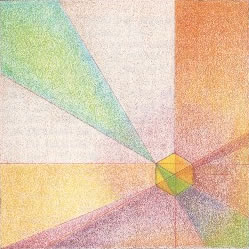Abscape™ from trip to Japan 1987
by Matt Taylor
Employing Group Genius
Building ValueWebs for a global economy
INTRODUCTION
I am greatly honored to be here and address you.
Let me start my remarks with an apology. It is for addressing you in my language instead of competently in yours. A measure of how truly global a country is can be found in the language plurality of it’s people. Japan is surly ahead of the US in this awareness and practice. Although I am sure that your English skills are far greater than my Japanese, I will pause periodically for translation. For this reason, and because I wish to make a number of complex points as clearly as I can, in a very brief period, I have chosen to read from a prepared statement. The dialog will be free and spontaneous.
Please, ask any questions you have as we proceed.
I am a student of Frank Lloyd Wright, an architect that greatly admired your culture and made a few notable contributions to your landscape. From Mr. Wright, I learned that a work of architecture should be based on a way of life. From Japan I learned about DOGU which I interpret as a way of work - or perhaps more accurately WORK as a way to self enlightenment.
My wife and partner, Gail Taylor, was a school teacher. She developed many innovations for education. We both believe that the process of leaning and the process of creativity are essentially the same. Learning is creativity aimed inward at self improvement. Creativity is learning aimed outward at making something in the world.
25 years ago, we thought about the great transformation that is taking place around our globe and what problems and opportunities this offered. Our model then - and now - is that society and business are becoming global. Knowledge work will be the basis of this global economy and the form of the economy will be distributed networks that defy traditional boundaries. Our conclusion was that this transformation would fundamentally undermine every organization that exists. Our answer to the apparent dilemmas engendered by this rate and scale of change is that a new way of working is necessary and this way is the PATH to the re-creation of our social and business institutions.
Since 1975, we have been prototying and operating environments for learning, creativity, innovation and the incubation of new organizations.
Today, I am going to show you what we have learned about building environments that facilitate the GROUP GENIUS necessary for solving large scale systemic problems.
In a way you can think of it as the return of some fundamentally Japanese ideas via Frank Lloyd Wright, my 44 years of practice, and the thousand times this way of working has been applied to the everyday problems of business and government all over the globe. Please think of it a gift offered with respect.
show tape
The video tape that you just saw was produced real time at the knOwhere Store as a final celebration of a DesignShop® process for Kaiser Permanente - a US health care organization. It is not a comprehensive coverage of the process. It was used to provide the group with a brief feedback of what they had experienced and accomplished in their three days.
It does demonstrate a typical use of multimedia in real time.
What We Do
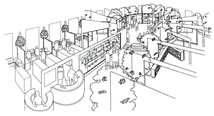 We release Group Genius. We build and operate environments that promote and facilitate rapid time to value, innovation and precise implementation. We design and configure work augmentation tool kits. We transfer these capabilities to partners and clients. In doing this, we build ValueWebs.
We release Group Genius. We build and operate environments that promote and facilitate rapid time to value, innovation and precise implementation. We design and configure work augmentation tool kits. We transfer these capabilities to partners and clients. In doing this, we build ValueWebs.
examples: Independent Bankers, FAA
Why We Do It
Existing design and decision-making processes cannot deal with the rate of change, complexity, scale and scope of modern systemic problems. This promotes unintended consequences, sub-optimization, bad decisions and harmful side effects.
Organizations largely tend to scope a problem that they are concerned with to the limits of their own immediate enterprise and the tools they have for solving the problem. They may work very diligently but if the problem is truly larger than their definition of it they will fail in their efforts. We provide them the means to overcome this. We have found that if organizations can embrace the true scale, scope and complexity of the work they will make far better designs and implementations.
examples: AEDC,EA
How We Do It
By operating a rigorous system and method of work that is a friendly open, organic environment while applying multimedia and networking tools in a way that augments human creativity.
We create PLACES that run by new rules. The integrity of these work places is kept intact under all circumstances. These place are our best practice of the future state that we are steering the enterprise towards. In this “future” place people design their future.
 We do not focus on organizations. We focus on their ValueWebs. A ValueWeb is composed of all investors, customers, producers, and a SYSTEM INTEGRATOR (management). The system integrator is not to be confused with traditional management. The is a greatly expanded idea of ENTERPRISE.
We do not focus on organizations. We focus on their ValueWebs. A ValueWeb is composed of all investors, customers, producers, and a SYSTEM INTEGRATOR (management). The system integrator is not to be confused with traditional management. The is a greatly expanded idea of ENTERPRISE.
The ENTERPRISE that actually creates value IS this web, not its parts.
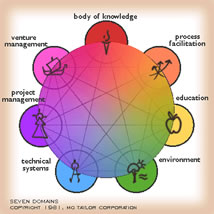 Complete integration of process, tools and environment is necessary. Managing people is not. I is the 7 Domains: Body of Knowledge, Work Process Design and Facilitation, Education and Training, Physical Environment, Technical Systems, Project Management, Venture Management - that has to be managed as a system.
Complete integration of process, tools and environment is necessary. Managing people is not. I is the 7 Domains: Body of Knowledge, Work Process Design and Facilitation, Education and Training, Physical Environment, Technical Systems, Project Management, Venture Management - that has to be managed as a system.
Our first step with any client or project is to perform, with appropriate ValueWebs members, a 7 Domains Audit. Given the goal, where are we weak and strong in the 7 Domains? How are they working as a system? Which web members have the best capacity? Is this ENVIRONMENT at all like the place we want to be? What concrete steps must we take to make it so?
The environment is then made into the best possible expression of the END-STATE and ValueWeb members are brought in to do many rapid iterations of design until a new solution emerges. Part of this solution is always the implementation details. Using this approach, 23% of the cost of the F-15 was taken out of the system in four one-week events of about a hundred people over 18 months. Over 40,000 people are, globally, part of this system. Each event had a different mix of participants. Other activities were coordinated in what we can a PATCHWORKS DESIGN process.
AEDC, a US Air Force testing facility has a 8,000 square foot (approximately, 800 square meters) NavCenter to do this and other similar work.
Environments
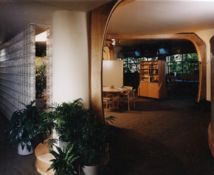 NavCenters are environments we build for our clients. They are a NEUTRAL place in an organization where collaboration free of traditional constraints can take be incubated. They go beyond brainstorming and become the “mind of the organization” - the place where the GENIUS of the organizations is kept alive.
NavCenters are environments we build for our clients. They are a NEUTRAL place in an organization where collaboration free of traditional constraints can take be incubated. They go beyond brainstorming and become the “mind of the organization” - the place where the GENIUS of the organizations is kept alive.
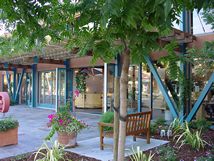 knOwhere Stores are the environments that we operate. This picture is our facility in Palo Alto, California. At knOwhere, we have retail to supply our clients and partners with tools and WorkFurniture systems, work spaces for office hotelling and business incubation, the offices of our own companies, and space for facilitating our clients and partners through intensive collaborative design sessions of one to several days.
knOwhere Stores are the environments that we operate. This picture is our facility in Palo Alto, California. At knOwhere, we have retail to supply our clients and partners with tools and WorkFurniture systems, work spaces for office hotelling and business incubation, the offices of our own companies, and space for facilitating our clients and partners through intensive collaborative design sessions of one to several days.
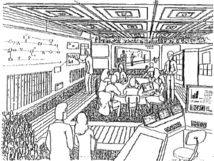 This diagram is from the cover of our 1982 Business Plan. It shows many elements of the the system we have developed since then: Today, all these elements are in place with the exception of the large work walls and the intelligent aspect of the computer system. The walls are a matter of time and we are starting work, based on our patent, on the software.
This diagram is from the cover of our 1982 Business Plan. It shows many elements of the the system we have developed since then: Today, all these elements are in place with the exception of the large work walls and the intelligent aspect of the computer system. The walls are a matter of time and we are starting work, based on our patent, on the software.
The WORK PROCESS, however, has been test over a thousand times all over the globe through our work, our clients work and CGEY who has a license to practice our DesignShop process. This is why we know it works. We practice the algorithms of the computer system, now, with Knowledge workers.
Work Processes
Group Genius. ValueWeb. Seamless user experience. Essence of the process.
Tool kits
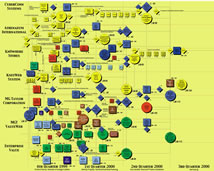 AndMaps. Situation Walls. Models and Language. Technology and multimedia.
AndMaps. Situation Walls. Models and Language. Technology and multimedia.
examples: Mentor environment/process; Banking software conversion
Product- Service Packages
DesignShops. Weak Signal Research - 10 Step Process. Modeling Language. NavCenter systems. RDS. CyberCon Executive System.
The basic system and method
Recursion, iteration, feedback, language levels, means of transacting.
project diagram: patent Table/language
How It has been Applied
Mini case studies: Natural Horizons. FAA. Tupperware. Capital Holding. AEDC. F-15. NASA. CGEY. Borgess Health Care. Detroit Edison. EA. HPD.
We are still early on the adaption curve.
DesignShop experiences are the lab (for 23 years). The way of doing the WHOLE system for a transient period. NavCenters are nacent. Each has done some part of the system for some period of time.
It does WORK. Now, the tools exist to finish engineering/building the non-event processes and tools. Now, the market is responding and is faced with the need.
What We Have Learned
Group Genius is not individual genius added up. It results from a different process. These two forms of genius CAN work together but his requires careful facilitation and a new practice of organization.
examples: brain metaphor
When given the tools, people can deal with complexity and rapid change - and, they can do it without creating harmful side effects.
There are long and short time scales that have to be managed.
examples: manic behavior
How it Can be Applied In Japan
Do not evolve out of existing structures. Create new seeds. Weave a larger network made up of the old and the new. Define new rules-of-engagement for these ValueWebs.
Start with a PLACE. Expand the network. Silicon Valley grew organically.
Why Japan?
 This is my personal perspective. Japan has the craftsmanship to implement a robust version of this system. We at MG Taylor and knOwhere are looking for partners to do this. Japan is seeking a way to improve innovation and entrepreneurial spirit while building on the strength of it’s culture. A system and method that is effective and is culturally adaptive is necessary.
This is my personal perspective. Japan has the craftsmanship to implement a robust version of this system. We at MG Taylor and knOwhere are looking for partners to do this. Japan is seeking a way to improve innovation and entrepreneurial spirit while building on the strength of it’s culture. A system and method that is effective and is culturally adaptive is necessary.
The Coke SAP implementation DesignShop process had to garner input and participation from over 160 countries. This method has been tried in all cultures and in many mixes of cultures. The reason why the method is so cross-cultural is the way it was designed and how it is employed. FEEDBACK is built-in. The design is done only with participation of the people who are impacted. It builds a common language, through mutual experience, as the first step in the work.
Japan has long mastered Keiretsu. A ValueWeb is similar and different in significant ways. A ValueWeb is more flexible in it’s structure and easily adaptive in real time. A ValueWeb includes customers and end-users in it’s work processes and governance. The ValueWeb Model is gaining recognition as a candidate for the next integrating business paradigm. Japan is a leader in significant aspects of this kind of linkage system.
The growing focus on design also presents an interesting opportunity for Japan. Design sensibility and attention to detail is distinctive in the Japanese culture. These make valuable core competences in future enterprise.
Conclusions
The transformation of the global economy adds tremendous complexity to organizational work. Added to this is the fact that a network economy is intrinsically more complex and fast changing than the industrial economy. Technology, itself, is increasingly complex. A crowded world with growing aspirations adds to the mix. All this gives rise to SYSTEMIC problems - problems that cannot be solved from a narrow “parts” perspective.
Linear methods of meetings and group process are inadequate to deal with the scale, scope and complexity integral to these problems. Existing environments impose hidden restrictions that make people adapt ther work processes to the environment. The environment should seamlessly adapt to people’s requirements. A system and method that effectively facilitates the interactions of large groups and communities of large groups is necessary. This is the only possible way the bring the necessary expertise and representation to bare on the issues. Only a ValueWeb architecture can solve the design challenges and effectively implement programs of this character. A network architecture, however, cannot be managed like an industrial organization. It requires the exercise of Group Genius.
MG Taylor and knOwhere have developed a system and method of work, and field tested it with organizations of all kinds for over 23 years, that meets these challenges. This method is not a collection of parts gathered here and there. It was designed from the beginning to work the way it does. While is has been constantly evolved and improved, it has functioned as essentially the same system for 23 years doing real work for real organizations. Problems related to start up efforts to those of immense complexity involving communities of businesses and governments have been resolved with great time compression and innovative results. This system and method is so unique that the US government will be issuing a patent within the next 90 days.
This WAY of working is highly compatible with Japanese culture and can be used to facilitate business issues of all kinds while also encouraging the development of a more entrepreneurial and innovative culture. This is not an abstract way that has to be learned then implemented. It is a PRACTICE that can be performed starting with day one. It is not a concept - it is a tested method. It integrates investor, customer and producer interests into wealth-building ValueWebs that have the variety and viability to sustain and recreate themselves to prosper in the 21st Century.
Matt Taylor
Palo Alto
April 8, 2001
Contextual Notes for this presentation
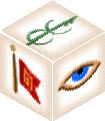
SolutionBox voice of this document:
VISION • STRATEGY • EVALUATION
posted April 8, 2001
revised April 19, 2001
• 20010408.633121.mt • 20010409.234697.mt • 20010417.389971.mt •
• 20010418.227641.mt • 200104 19.769344.mt • 20010421.118634.mt •
20010424.472987.mt • 20010426.662901.mt •
(note: this document is about 75% finished)
Matt Taylor 650 814 1192
Copyright© Matt Taylor 2001
